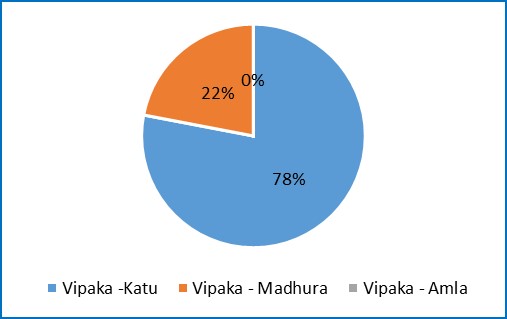Critical analysis of Vidangakrishnadi Yoga w.s.r. to Krimihara action
Abstract
The analysis of the formulation (Yoga) pertaining to its mode of action is an important area in assuring the therapeutic efficacy and safety. Krimiroga being a common presentation in pediatric age group, the probable action of the drug is more relevant considering the Aparipakvaavastha of the children. Lakshanas of Pureeshaja Krimi described in Ayurvedic classics are Vivarnatha (Discoloration of the face), Shoola (Pain in abdomen), Bhaktadwesha (Aversion to food), Atisaara (Loose stools), Sadana (Generalized Debility), Jwara (fever) and Gudakandu (Anal itching). According to Ayurveda, the principle of treatment for Krimi includes Apakarshana, Prakruti Vighata and Nidana Parivarjana. Among these Samshamana is easier to be administered in children, so such formulation is being adopted. Vidangakrishnadiyoga is a Kashayayoga explained in Sahasrayoga in Kashayaprakarana. The indications sole action of Yoga is indicated as Krimihara. There are 9 drugs in the Yoga which are collectively Krimihara, Deepana and Pachana in action. The drugs are Vidanga, Pippali, Maricha, Nirgundi, Shigru, Bharangi, Musta and Aakhukarni. This article is a review of the Vidangakrishnadi Yoga considering the Rasadigunas of the ingredients.
Downloads
References
Sharma Ram Karan, Dash Vaidya Bhagwan. Charaka Samhita of Agnivesha Text with English Translation & Critical Exposition Based on (Cakrapanidatta’s Ayurveda Dipika). Varanasi: Chaukhamba Sanskrit Series. Vimanasthana; Vyadhitharoopiya adhyaya: Chapter 7, Verse 9, 2009( II),p199
Parthasarathy A et al. IAP Textbook of Pediatrics. Gwalior: IAP National Publication House. 5th ed, 2013;p51.
Ghai OP, Paul VK, Bagga Aravind. Ghai Essential Pediatrics. New Delhi: CB Publishers and distributors. 7th ed, 2009;p246.
Behrman, Kleigman, Jenson. Nelson’s Text Book of Pediatrics. Pennsylvania, WB. 1st ed, Saunders Company; 2016(II),p1733-39.
Parthasarathy A et al. IAP Textbook of Pediatrics. Gwalior: IAP National Publication House; 5th ed, 2013;p51.
Tripathi KD. Essentials of medical pharmacology. New Delhi: Jaypee brothers Medical Publishers; 6th ed, 2010;p810.
Sharma Ram Karan, Dash Vaidya Bhagwan. Charaka Samhita of Agnivesha Text with English Translation & Critical Exposition Based on (Cakrapanidatta’s Ayurveda Dipika), vimanasthana; Vyadhitharoopiya adhyaya: Chapter 7, Verse 14. Varanasi: Chaukhamba Sanskrit Series. 2009( II). P.203.
Krishnan KV, Gopalan Pillai AK. Sahasrayogam. Aleppy: Vidyarambam Publishers. 32nd ed, Kashaya Prakarana, verse 5. 2013;p54.
Sastry JLN. Illustrated Dravyaguna Vijnana,Study of the Essential Medicinal Plants in Ayurveda. Varanasi: Chaukambha Orientalia. 2010(II), P318, 448, 452, 411, 139,422,519,862,551.
Sharma Ram Karan, Dash Vaidya Bhagwan. Charaka samhita of Agnivesha Text with English Translation & Critical Exposition Based on (Cakrapani Datta’s AyurvedaDipika), vimana sthana; Rogabhishkjitheeya adhyaya: Chapter 8, Verse 96. Varanasi:Chaukhamba Sanskrit Series; 2009( II). P.263.
Rajagopal PL et al. Phytochemical and Anthelmintic studies on the whole plant of Merremia emarginata Burm. F. American Journal of Pharmacy & Health Research 2014.
Raul et al. Comparitive Study of Anthelmintic Activity of Vitex negundo, Moringa oleifera, Tamarindus indica on Indian Earthworm Phertima posthuman
Lal B, Mishra N. Importance of Embelia ribes: An Update. Int J Pharm Sci Res. 2013: 4(10); 3823-3838. doi: 10.13040/IJPSR. 0975-8232.4(10).3823-38
Prashantra KR Deb et al. Comparative anthelmintic activity of Clerodendrum indicum & Alpinia galanga leaves
Veerabhadrappa KV et al. Evaluation of Anthelmintic Activity of isolated Piperine and Hydroalcoholic Extract from Pepper
Suresh Kasala et al. Preliminary phytochemical screening and in vitro anthelmintic activity of Cyperus rotundus (L)
Krishn Kumar Agrawal et al. In-vitro anthelmintic screening of vitex negundo linn
Sheeja T Tharakan, Manju Madhavan. Therapeutic potential of piper longum
Gobinda Narayan Goswami et al. Anthelmintic activity of crude extract of zingiber officinale (zingiberaceae)














